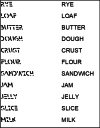Distinctive Sans Forgetica font does not benefit memory accuracy in the DRM paradigm
- PMID: 36484976
- PMCID: PMC9733772
- DOI: 10.1186/s41235-022-00448-9
Distinctive Sans Forgetica font does not benefit memory accuracy in the DRM paradigm
Abstract
A common method used by memory scholars to enhance retention is to make materials more challenging to learn-a benefit termed desirable difficulties. Recently, researchers have investigated the efficacy of Sans Forgetica, a perceptually disfluent/distinctive font which may increase processing effort required at study and enhance memory as a result. We examined the effects of Sans Forgetica relative to a standard control font (Arial) on both correct memory and associative memory errors using the Deese/Roediger-McDermott (DRM) false memory paradigm, to evaluate Sans Forgetica effects on overall memory accuracy. Across four experiments, which included nearly 300 participants, Sans Forgetica was found to have no impact on correct or false memory of DRM lists relative to a standard Arial control font, regardless of whether font type was manipulated within or between subjects or whether memory was assessed via free recall or recognition testing. Our results indicate that Sans Forgetica is ineffective for improving memory accuracy even when accounting for associative memory errors.
Keywords: Associative memory errors; Distinctiveness; Free recall; Recognition; Sans Forgetica.
© 2022. The Author(s).
Conflict of interest statement
The authors report no conflicts of interest.
Figures
Similar articles
-
Disfluent difficulties are not desirable difficulties: the (lack of) effect of Sans Forgetica on memory.Memory. 2020 Aug;28(7):850-857. doi: 10.1080/09658211.2020.1758726. Epub 2020 May 4. Memory. 2020. PMID: 32364830
-
Sans Forgetica is not desirable for learning.Memory. 2020 Sep;28(8):957-967. doi: 10.1080/09658211.2020.1797096. Epub 2020 Jul 29. Memory. 2020. PMID: 32723219
-
Recognition of Studied Words in Perceptual Disfluent Sans Forgetica Font.Vision (Basel). 2022 Aug 24;6(3):52. doi: 10.3390/vision6030052. Vision (Basel). 2022. PMID: 36136745 Free PMC article.
-
How are false memories distinguishable from true memories in the Deese-Roediger-McDermott paradigm? A review of the findings.Psychol Res. 2013 Nov;77(6):671-86. doi: 10.1007/s00426-012-0472-6. Epub 2012 Dec 25. Psychol Res. 2013. PMID: 23266577 Review.
-
[False memory in normal aging: empirical data from the DRM paradigm and theoretical perspectives].Geriatr Psychol Neuropsychiatr Vieil. 2020 Mar 1;18(1):65-75. doi: 10.1684/pnv.2020.0842. Geriatr Psychol Neuropsychiatr Vieil. 2020. PMID: 32160987 Review. French.
Cited by
-
The font size effect depends on inter-item relation.Mem Cognit. 2023 Oct;51(7):1702-1713. doi: 10.3758/s13421-023-01419-1. Epub 2023 Mar 30. Mem Cognit. 2023. PMID: 36995573
References
-
- Arndt J, Reder LM. The effect of distinctive visual information on false recognition. Journal of Memory and Language. 2003;48(1):1–15. doi: 10.1016/S0749-596X(02)00518-1. - DOI
-
- Bjork EL, Bjork RA. Making things hard on yourself, but in a good way: Creating desirable difficulties to enhance learning. In: Gernsbacher MA, Pew RW, Hough LM, Pomerantz JR, editors. Psychology and the real world: Essays illustrating fundamental contributions to society. Worth Publishers; 2011. pp. 56–64.
-
- Bjork RA. Memory and metamemory considerations in the training of human beings. In: Metcalfe J, Shimamura AP, editors. Metacognition: Knowing about knowing. The MIT Press; 1994. pp. 185–205.
-
- Bjork RA, Bjork EL. Desirable difficulties in theory and practice. Journal of Applied Research in Memory and Cognition. 2020;9(4):475–479. doi: 10.1016/j.jarmac.2020.09.003. - DOI
MeSH terms
LinkOut - more resources
Full Text Sources

